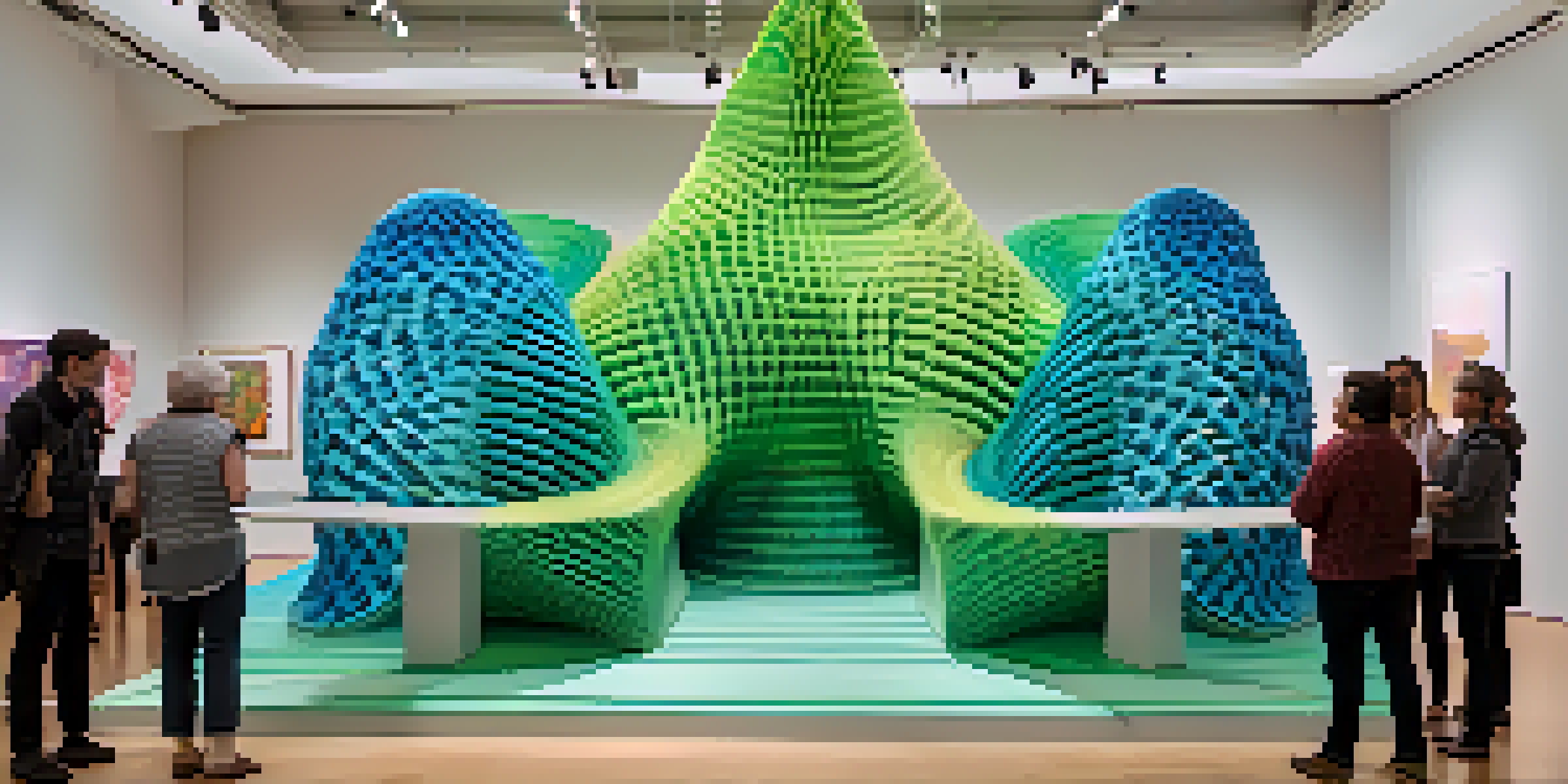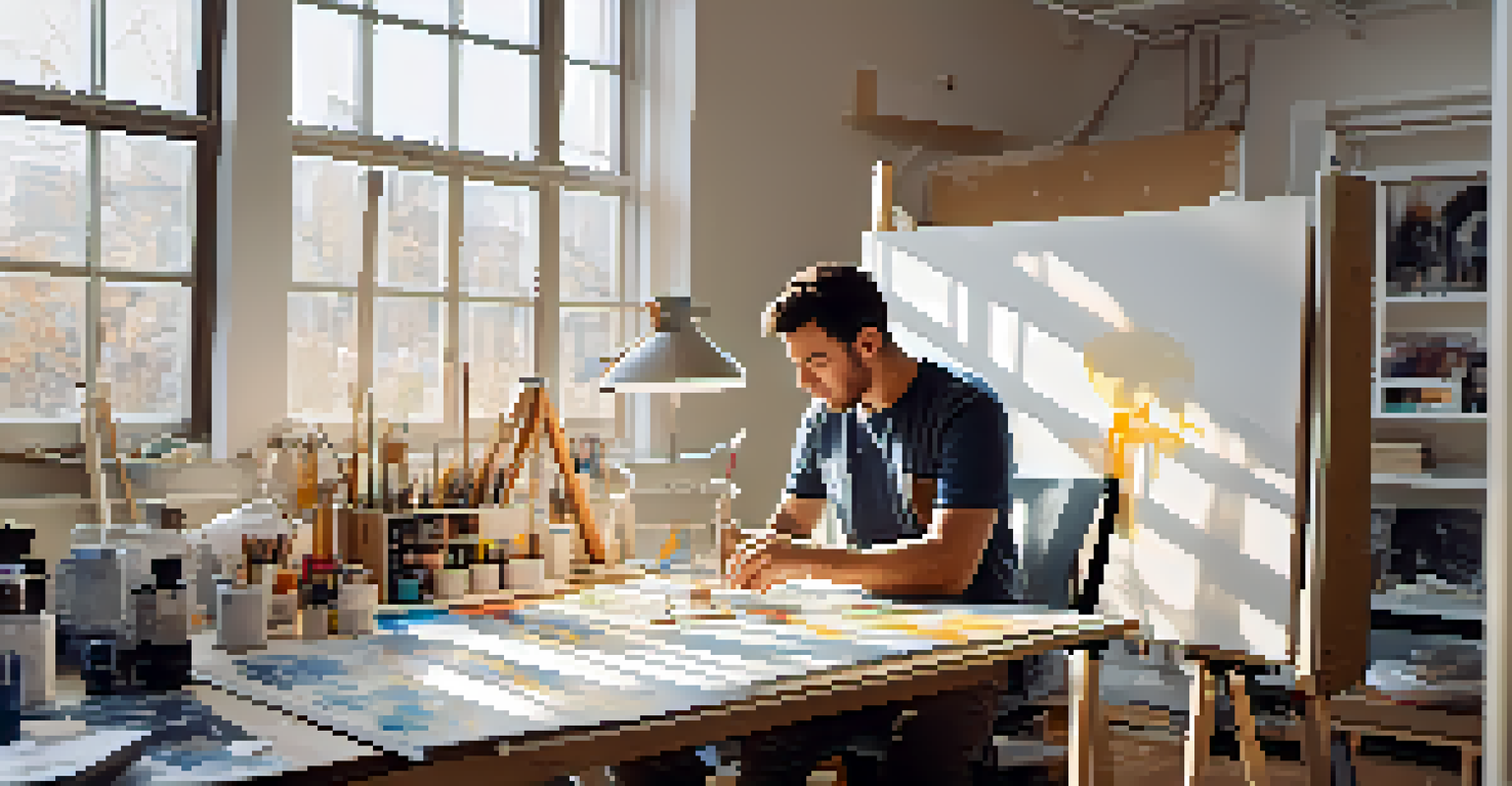3D Printing in Art: Revolutionizing Sculpture and Painting

The Intersection of Technology and Traditional Art Forms
3D printing has emerged as a groundbreaking technology that merges the realms of art and science. Artists are now able to create intricate sculptures and paintings with a precision that was unimaginable just a few decades ago. This intersection not only enhances creativity but also challenges the traditional boundaries of what art can be.
Art is the most beautiful of all lies.
For instance, an artist can design a complex sculpture on a computer and then bring it to life using a 3D printer. This process allows for experimentation with shapes and materials, pushing the limits of artistic expression. The ability to visualize and create detailed designs on screen has opened new avenues for artists to explore.
Moreover, 3D printing democratizes art-making, allowing artists from diverse backgrounds to experiment without the need for extensive resources. This shift is not just about technology; it's about reimagining the creative process itself.
How 3D Printing is Changing Sculpture Creation
Sculpture has traditionally involved materials like clay, stone, or metal, requiring significant skill and manual labor. However, 3D printing transforms this landscape by enabling artists to produce complex forms with ease. Artists can now focus more on conceptualization rather than the labor-intensive aspects of sculpting.

For example, consider the work of contemporary artist Nick Ervinck, who uses 3D printing to create vibrant, large-scale sculptures that combine digital design with traditional art forms. His approach demonstrates how technology can enhance artistic vision, allowing for pieces that are both innovative and visually stunning.
3D Printing Transforms Artistic Creation
3D printing empowers artists to create intricate sculptures and paintings, redefining traditional boundaries of art.
Furthermore, 3D printing allows for rapid prototyping, meaning artists can create and refine their designs quickly. This agility is crucial in an art world that values originality and timely relevance, enabling artists to respond to trends and ideas almost instantaneously.
Innovations in 3D Printing Materials for Art
One of the most exciting aspects of 3D printing is the variety of materials available for artists. From biodegradable plastics to metals and even ceramics, artists can choose materials that best suit their vision. This versatility allows for a richer exploration of texture and finish in their work.
The great thing about technology is that it allows you to do more with less.
For instance, some artists are experimenting with flexible filaments that create dynamic, movable sculptures. This opens up new possibilities for kinetic art, where movement adds another layer of engagement for the viewer. The choice of material can significantly influence the aesthetic and conceptual message of a piece.
Moreover, advancements in material science continue to expand what's possible in 3D printing. Artists can now incorporate smart materials that respond to their environment, adding an interactive element to their creations. This fusion of art and technology not only captivates audiences but also invites them to participate in the experience.
Bridging the Gap Between Digital and Physical Art
3D printing serves as a bridge between digital art and traditional physical forms. Artists can create stunning digital artworks and then translate them into tangible pieces through 3D printing. This process allows for a seamless transition between different mediums, enhancing the overall artistic experience.
For example, many digital artists are using 3D printing to produce physical versions of their virtual creations. This not only validates their work but also gives audiences a new way to appreciate digital art. The interplay between what exists on-screen and what can be touched adds depth to the viewer's engagement.
New Materials Expand Artistic Possibilities
The variety of materials available for 3D printing enables artists to explore innovative textures and interactive elements in their work.
Additionally, this blending of mediums encourages collaboration among artists from different backgrounds. Digital artists can team up with traditional sculptors or painters, creating a fusion of skills and ideas that leads to innovative art forms. This collaborative spirit is at the heart of the contemporary art scene.
3D Printing in Painting: A New Dimension of Expression
While 3D printing is often associated with sculpture, its impact on painting is equally significant. Artists are now able to create textured, layered paintings that add a new dimension to their work. By using 3D printers to apply paint in various patterns, artists can achieve effects that would be challenging to replicate by hand.
For instance, artists like Kwangho Lee explore the potential of 3D printing to create vibrant, tactile paintings that play with the perception of depth. These pieces invite viewers to not only see but also experience the artwork in a more visceral way. This tactile quality transforms the traditional viewing experience, making it more interactive.
Moreover, the use of 3D printing in painting encourages experimentation with color and form. Artists can create complex designs and textures that push the boundaries of what painting can be, leading to a redefinition of the medium itself. This innovative approach continues to inspire new generations of artists.
The Role of 3D Printing in Art Education
The integration of 3D printing into art education is revolutionizing how students learn and create. Schools and universities are increasingly incorporating this technology into their curricula, allowing students to explore new techniques and ideas. This hands-on experience prepares them for the evolving art landscape.
For example, art students can use 3D printers to bring their concepts to life, fostering a deeper understanding of spatial relationships and material properties. This practical knowledge is invaluable as they develop their artistic voice. Moreover, learning to use this technology enhances their marketability in a competitive job landscape.
Collaboration Enhances Art Education
Integrating 3D printing in art education fosters collaboration among students, enhancing creativity and preparing them for future projects.
Additionally, educators are discovering that 3D printing encourages collaboration among students. Working on projects together allows them to share ideas and techniques, fostering a sense of community. This collaborative environment not only enhances creativity but also prepares students for future collaborative art projects.
Challenges and Considerations in 3D Art Printing
Despite its many benefits, 3D printing in art does come with challenges. One major concern is the environmental impact of certain materials used in the printing process. Artists and manufacturers must navigate this issue carefully, seeking sustainable alternatives that align with their values.
Moreover, the accessibility of 3D printing technology can also pose a barrier for some artists. While prices have dropped, high-quality printers and materials can still be out of reach for emerging artists. Finding ways to democratize access to this technology is crucial to ensuring that all artists can benefit from its possibilities.

Lastly, as with any technology, there are concerns about the authenticity of art created through 3D printing. Questions arise about originality and ownership, prompting discussions within the art community about what it means to be an artist in a digital age. These ongoing dialogues are essential as we navigate the future of art and technology.